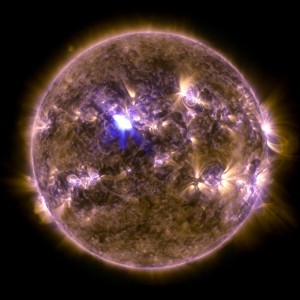The strongest solar flare in 2013 should impact the Earth’s upper atmosphere this weekend on April 13-14, 2013.

NASA’s Solar Dynamics Observatory captured this image of an M6.5 class solar flare at 3:16 EDT on April 11, 2013. It will impact the Earth this weekend. (Photo: NASA/SDO)
Solar flares are strong bursts of radiation that sling powerful material through space toward Earth (known as a CME or coronal mass ejection), and some can be quite harmful. Most CMEs reach the Earth in one to three days after they have ejected from the Sun’s surface. A powerful CME pointed toward Earth moving over 600 miles per second can disturb the upper atmosphere enough to disrupt radio signals and affect electronic systems in satellites both in space and on the ground.
Although this particular mid-level flare is actually about ten times less powerful than some of the strongest flares that we’ve seen, the solar flare that occurred on April 11, 2013 produced a CME that could potentially create a geomagnetic storm, which occurs when the CME connects with the Earth’s magnetic shield for an extended period of time.
This is not the last solar flare or CME that will impact the Earth this year. Solar activity is likely to increase because the Sun’s normal 11-year cycle is just reaching its peak in late 2013.
This will be a great weekend to watch the auroras in the Northern latitudes, but head’s up – GPS and cell phone signals might undergo some disruption.

